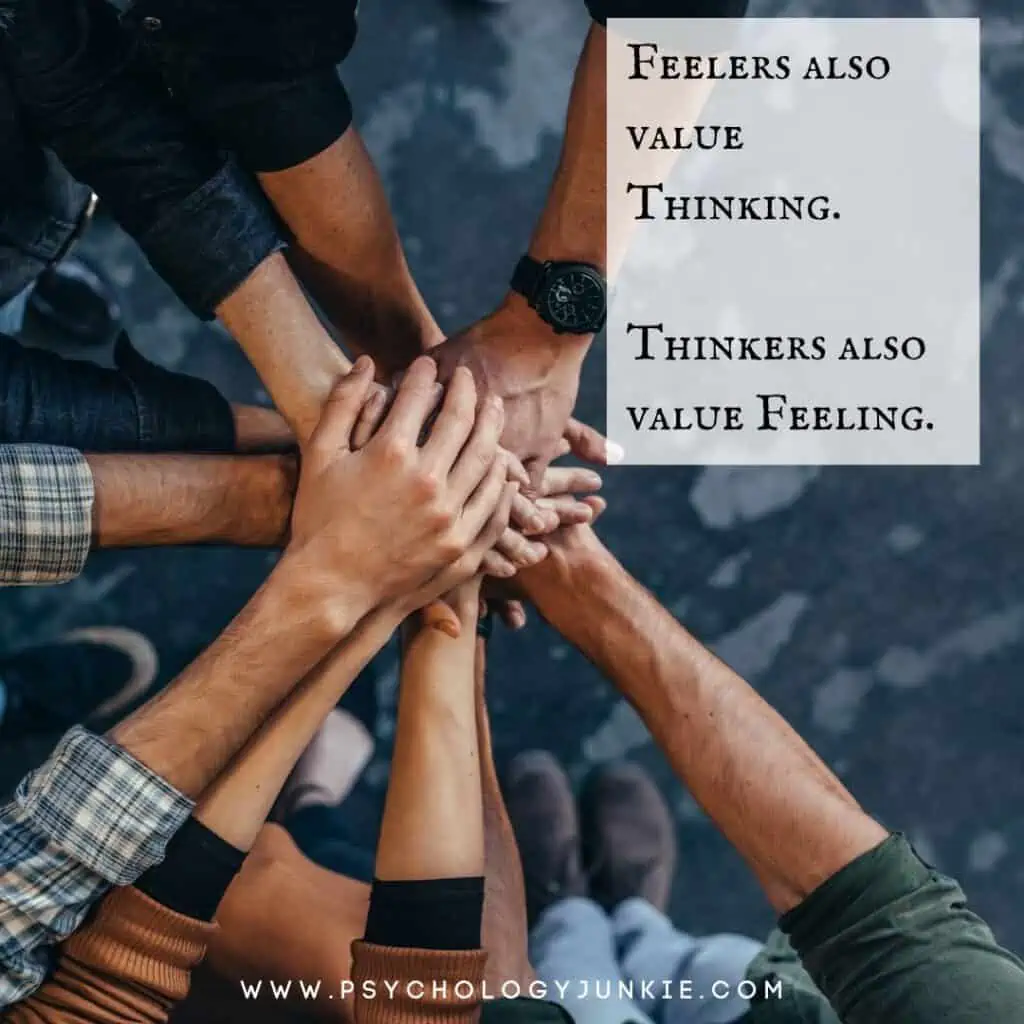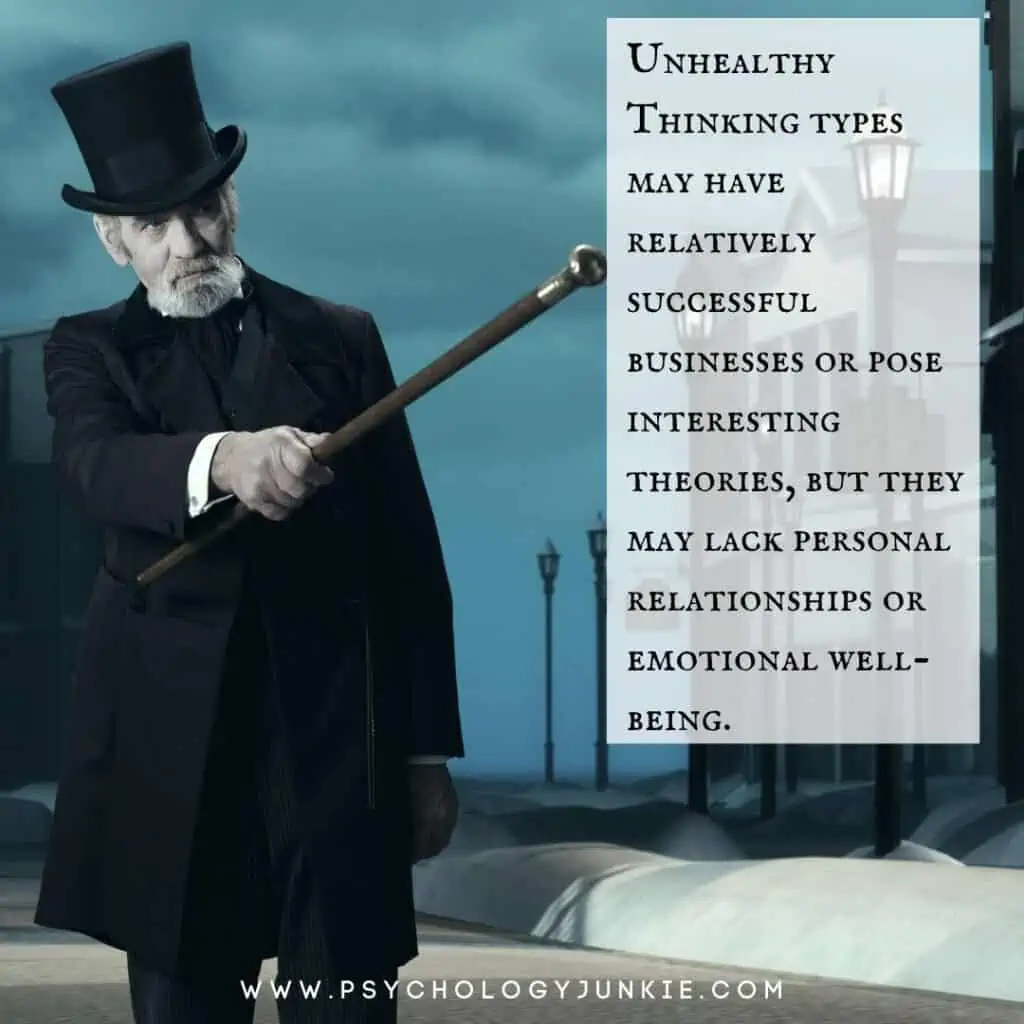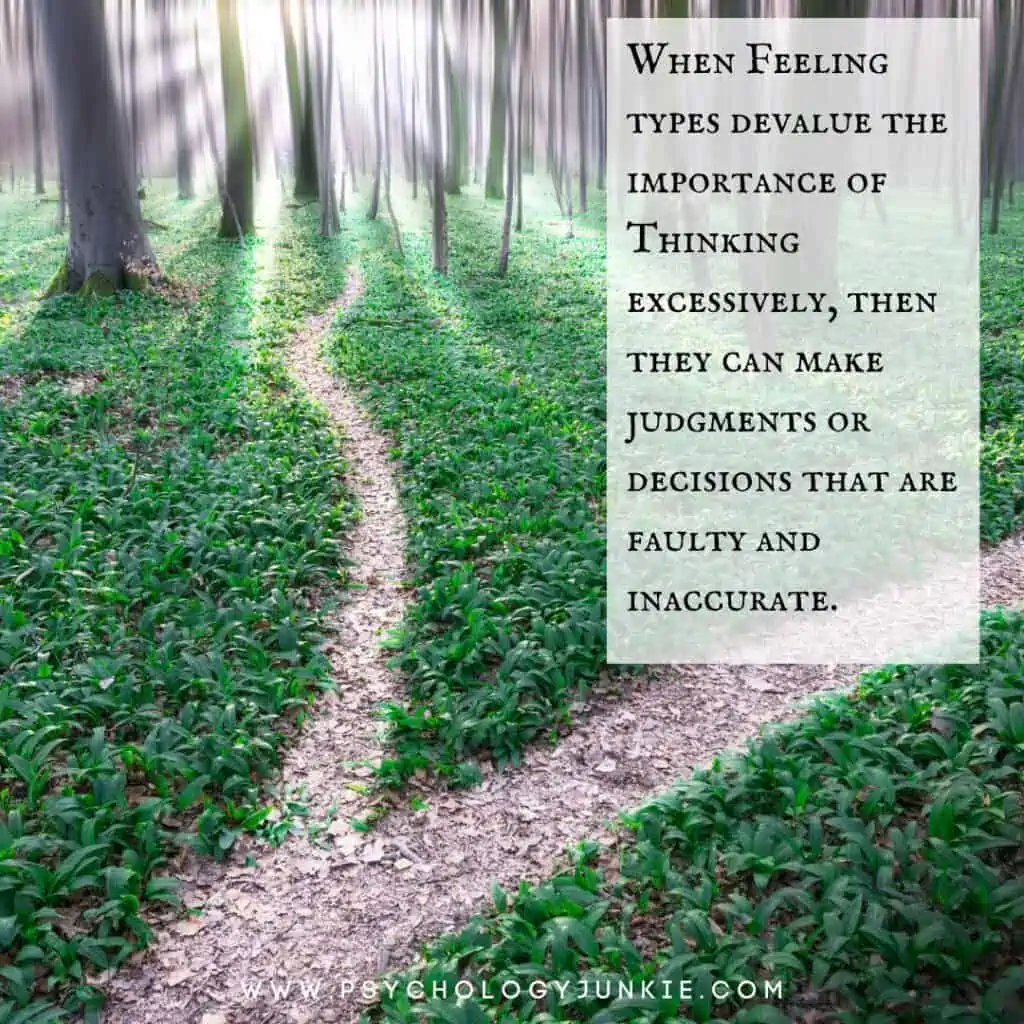Are Some Myers-Briggs® Personality Types Nicer Than Others?
Have you ever wondered if there was a quick and easy way to tell if someone is nice or not? Kind or unkind? A lot of people rely on questionnaires and psychometric tools like the Myers-Briggs Type Indicator to deduce such things. But is this really a good idea? Can a four-letter code really tell us whether someone has a kind heart or is inconsiderate and cruel?
Many places on the internet seem to think so! As an MBTI® practitioner I’ve seen time and time again where people have mistyped themselves as either “Feeling” (F) types or “Thinking” (T) types based on the assumption that they are either a “nice” or “cold” individual. I’ve seen people type others based on whether they were selfless, kind, helpful (“they must be a feeler!”) or more reserved and selfish (“totally a thinker!”).

When people first learn about the MBTI® they tend to classify people in very harsh ways:
“Thinkers are mean but smart!”
“Feelers are nice but not as smart!”
“Introverts hate people”
“Extroverts are loud and shallow”
“Intuitives are flighty”
“Sensors lack imagination!”
These kinds of negative generalizations work their way into blogs, YouTube videos, and podcasts that are meant to be taken seriously. If I do a quick Google search for fictional INFJs I can quickly find a list of the following people:
Remus Lupin from the Harry Potter series
Elsa from Frozen
Professor Albus Dumbledore
Obi-Wan Kenobi from Star Wars
Elizabeth Bennet from Pride and Prejudice
Izuku Midoriya from My Hero Academia
Jon Snow from Game of Thrones
If I try a search for ENTJs, I find a list of the following people:
Blair Waldorf from Gossip Girl
Patrick Bateman from American Psycho
Bane from The Dark Knight Rises
Miranda Priestley from The Devil Wears Prada
Sauron from The Lord of the Rings
Kathryn Merteuil from Cruel Intentions
Now if one were to look at these two lists of characters, one could easily deduce that INFJs are wise, mysterious, kind, and selfless. They could also deduce that ENTJs are manipulative, sociopathic, cruel, and ruthless.
But do those four letters really tell us how good or bad a person is?
Is the Myers-Briggs Type Indicator being misused?
Not sure what your personality type is? Take our new personality questionnaire here. Or you can take the official MBTI® here.
Table of contents
- Are Certain Personality Types “Nicer” Than Others?
- So what does this all mean?
- The Other Side of Thinking and Feeling Types
- Unhealthy Thinking
- Unhealthy Feeling
- Healthy Thinking and Feeling
- How Specific Personality Types Combine Their Thinking and Feeling Preferences:
- Ultimately, There Are No “Nicer” or “Meaner” Personality Types
- Did You Enjoy This Article?
Are Certain Personality Types “Nicer” Than Others?
In order to answer this question, I’m going to go directly to the authority: the official Myers-Briggs® Type Indicator Manual.
Here is their definition of the difference between Thinking or Feeling (T-F):
“The T-F pair is designed to reflect an individual’s preference for one of two opposite ways of deciding or making a judgment. A person may primarily rely on Thinking (T) to decide impersonally on the basis of logical consequences, or on Feeling (F) to decide on the basis of personal or social values. And, as is true for all the opposite preferences, individuals are free to exercise both Thinking and Feeling, regardless of their preference for one or the other.
In the Jung-Myers approach, the term Thinking does not imply intelligence or competence and the term Feeling is not to be confused with being emotional. Intelligence and emotional expression are independent of personality type. Intelligence varies within every type, and people of all types experience emotion.”
So what does this all mean?
Does making a decision by prioritizing impersonal logic turn someone into a Patrick Bateman-esque sociopath who galavants around Wall Street murdering anyone who gets in his way? Does it denote materialism, lust for power, or evil?
Does making a decision by prioritizing personal or social values turn someone into a kind, thoughtful, conscientious person who would never hurt a fly?
When we reason with Thinking, we’re looking at cause-and-effect, pros and cons, and accuracy: “If I move to a new country, I will earn $50k more per year, have a stable contract, better provide for my family, and we can all learn to speak a new language and interact with a new culture. Ultimately the pros outweigh the cons.”
When we reason with Feeling, we weigh the effects of the decision on people’s feelings – sometimes our own feelings/values, sometimes on group feelings/values: “If I move to a new country I won’t know anyone and I’ll feel lonely. My kids will have to leave their friends and I feel wrong about that instability for them. My parents would be sad not to be close to us. But the change might draw us closer together as a family and be an adventure that inspires us.”
The Other Side of Thinking and Feeling Types
When most people learn about personality types, the exploration process stops at a fairly shallow level. Reading the above statements gives someone the conclusion that thinkers are logical and data-oriented while feelers are focused on emotional impact and values.
But there’s another piece to the puzzle…
Just like a coin has two sides, so do our personalities. If you are a Thinker (T type) you still have access to feeling. If you are a Feeler (F type) you still have access to thinking. The analytical process for most people doesn’t simply stop once the preferred Thinking or Feeling data has been reviewed.
A Thinker will typically start analyzing a decision by looking at data, metrics, and cause and effect. But usually somewhere towards the end of that process they will also review their values. However, the items in the Thinking scale will typically weigh heavier than the items in the Feeling scale. This can show up in thinking like this: “I know a big move like this will be a tough change emotionally for my family, but the pros outweigh the cons and we can still visit family regularly with the increased salary I’ll be making.”
A Feeler will typically start analyzing a decision by looking at their individual or social values and the emotional ramifications involved. But towards the end of that process, they’ll also consider the metrics, data, and cause and effect. However, the items in the Feeling scale will usually weigh heavier than the items in the Thinking scale. This can show up as someone thinking, “I know the job makes more money and is financially more stable. I just don’t feel right about leaving my family and friends – family is an important value to me that I can’t betray.”
Feeling types can be very logical and analytical, but they’ll naturally focus on their Feeling values more readily and quickly.
Thinking types can be very emotionally in-tune and value-oriented, but they’ll typically notice Thinking metrics and analysis first and trust their judgment in this area more fully.
And to make matters more nuanced, most Thinking types will have values they won’t betray regardless of how logical it is. “It makes all kinds of financial sense to move countries for my job, but I made a promise to my kids I wouldn’t move them again. I can’t betray that value.”
Most Feeling types will have logic they won’t betray regardless of how it aligns with their values. “I really want to give this $100 to help out a friend, but I know logically I need to pay my bills instead.”
Unhealthy Thinking
When Thinking types devalue the importance of Feeling excessively, then they can appear like the Ebenezer Scrooge’s of the world. Rather than focusing on the well-being or emotional experiences of themselves or others, they focus on facts, figures, data, and metrics. But underneath all that impersonal data is a feeling-side that’s increasingly vulnerable and still causing influence and unhealthy projections (“I don’t want to help others, because nobody helped me. I’m still heartbroken that I was rejected so I’ll reject everyone else before they can reject me.”) Unhealthy Thinking types may have relatively successful businesses or pose interesting theories, but they may lack personal relationships or emotional well-being.
Unhealthy Feeling
When Feeling types devalue the importance of Thinking excessively, then they can make judgments or decisions that are faulty and inaccurate. Some Feeling types prioritize group values, and if they’re too excessive in that regard they may become cliquey and unkind in order to stay aligned with the dominant social group. Some Feeling types prioritize individual values, and if they’re too excessive in that regard they may become so locked in their own inner emotional world that they’re out of touch with reality, with how others feel, and become enraged by anything that upsets their internal feeling values. People may feel like they have to walk on eggshells around them because they’re never sure what invisible internal value they could be upsetting.
Underneath all these Feeling values is a Thinking-side that is increasingly vulnerable and still causing influence (“I have all the metrics and data to show why my feeling-values are correct…..but I only read them from a biased newspaper that agrees with me and I didn’t check their sources”)
Healthy Thinking and Feeling
Healthy Thinking types give both sides of their personality some input in their decision-making. They don’t focus only on data, metrics, and impersonal analysis. They also put their values into play.
- A healthy ENTJ might build a successful business that brings in a lot of money, but use 10% of the proceeds to help orphanages in a third-world country.
- A healthy ESTP might be known for their direct, no-nonsense way of speaking, but be the first person to show up when someone needs help or is in a crisis.
- A healthy INTP might come up with groundbreaking theories, but they may also help out in a soup kitchen every weekend and be favored for their quiet, gentle nature.
Healthy Feeling gives respect to its complementary Thinking side as well. Healthy Feelers don’t focus singularly on their values or the emotional impact of something. They also consider the metrics, data, and cause-and-effect.
- A healthy ENFJ might form an environmental awareness group and use thoroughly-researched data to convince people to recycle.
- A healthy ISFP might pursue her life as an artist by learning all the metrics and strategies involved with marketing one’s self on YouTube.
- A healthy ENFP might be unapologetically convincing and clear in a debate over one of his causes because he’s researched well, studied the arguments, and has solid ground to stand on.
It’s important to remember this:
Thinking types operate most easily in the world of data, metrics, and impersonal logic naturally. They also have values, feelings, and loyalties that are deeply important to them.
Feeling types operate most easily in the world of values, relationships, emotional experiences, and personal stories. They also value truth, reason, and logic unless they’re deeply unhealthy.
How Specific Personality Types Combine Their Thinking and Feeling Preferences:
xTxP Personality Types (ESTPs, ENTPs, ISTPs, INTPs)
Thinking-Perceiving personality types have a process called Introverted Thinking (or “Ti” for short) in the foreground of their mind. However, backing that process up is a process called Extraverted Feeling (or “Fe” for short). These two processes have the following focuses:
- Introverted Thinking (Ti): Understanding how things work and analyzing complexities to find logical principles. Deciphering and creating frameworks, checking for inconsistencies, clarifying definitions to get the utmost precision.
- Extraverted Feeling (Fe): Connecting with people and organizing the world to meet the needs and feelings of the whole. Maintaining societal, organizational, or social values; adjusting to accommodate others; creating emotional intimacy and “spark” with someone.
Because these two functions are working in tandem with each other, Thinking Perceiving personality types want to figure out how things work and have a clear mental map for how data fits together. They pair this clarity-seeking side of themselves with another side that wants to help people by producing something they can understand and find useful. This can show up as clarifying information, debating, generating intellectual discussion, or enjoying challenging mental tasks (games, riddles, or building/constructing). While TP personality types can initially seem very direct, skeptical, or even argumentative, they have a deep desire for harmonious relationships and rich emotional bonds. Often their efforts to clarify information, give data, and point out logical inconsistencies are made to help people have clearer thinking and higher-quality solutions. Usually the older and more mature a TP personality type becomes, the more they know how to accommodate and support people emotionally and adjust to the emotional feedback they’re getting.
Read This Next: How to Tap Into the Energy of Every Personality Type
xFxJ Personality Types (ESFJs, ENFJs, ISFJs, INFJs)
Feeling-Judging personality types have the same Thinking and Feeling mental processes as the Thinking-Perceiving personality types, but in a different order. FJs have Extraverted Feeling at the forefront of their mind, and Introverted Thinking backing it up. Because of this, FJs are deeply concerned with connecting with others and meeting peoples’ needs. They are in tune with the emotional wavelengths they are getting from someone and enjoy forging emotional intimacy with others. Social expectations are easy for them to notice and they can quickly ascertain whether something is appropriate or inappropriate. They enjoy utilizing these abilities to create logical principles to make the world a better place. This can look like coming up with principles for good or bad behavior in a classroom, implementing key psychological principles as a counselor or therapist, or researching and organizing data about various cultures as an anthropologist.
Just like the Thinking-Perceiver wants to know how things work, Feeling-Judgers want to know how people work and how their dynamics impact and affect each other.
Read This Next: The Life Lesson You Teach the World, Based On Your Myers-Briggs® Personality Type
xTxJ Personality Types (ESTJs, ENTJs, ISTJs, INTJs)
Thinking-Judging personality types have a process called Extraverted Thinking (or “Te” for short) in the foreground of their mind. However, backing up that process is another process called Introverted Feeling (or “Fi” for short). These two processes have the following focuses:
- Extraverted Thinking (Te): Ordering, segmenting, and organizing the outer world for efficiency. Applying logic, checking for consequences, and setting boundaries, guidelines, and parameters.
- Introverted Feeling (Fi): Considering the importance or worth of something (“What really matters?”), evaluating something based on the underlying values it’s based on, clarifying personal values, deciding if something is significant and worth standing up and fighting for.
Because these two functions work in tandem with each other, Thinking Judging personality types want to create a sense of order and direction in the world around them. They are “get things done” people who focus on outcomes and efficiency. Yet behind their blunt, decisive exterior is an inner desire to do things that deeply matter. Most Thinking-Judging personality types have a strong sense of belief that underlies their actions. Being authentic and aligned with their sense of right/wrong is important to them. Many have causes that matter deeply to them and they’d be willing to make huge sacrifices for.
Read This Next: The Mysterious Side of Each Myers-Briggs® Personality Type
xFxP Personality Types (ENFPs, ESFPs, INFPs, ISFPs)
Feeling-Perceiving personality types have a process called Introverted Feeling (or “Fi” for short) in the foreground of their mind. However, backing up that process is another process called Extraverted Thinking (or “Te” for short). FPs ultimately value the same forms of Thinking and Feeling that TJ personality types value. However, they value them in a different order!
Feeling-Perceivers are ultimately concerned with what matters to them on a personal level. They are constantly asking “What matters? What is significant?” They quickly see the values behind peoples’ actions and assess their own values to discern what they stand for as individuals. They may experiment with various value-systems to see what “feels right” and is authentic to them. But there’s another side to the Feeling Perceiver! The Extraverted Thinking side gives them a desire for effectiveness and structure, as well as a drive to implement their values in a proactive, productive way. They set boundaries in their relationships if someone is obstructing their ability to stay true to their values. They follow their own guidelines for how they will stick up for their personal beliefs and be authentic and purposeful in the world.
Read This Next: The Literary Heroine You’d Be, Based On Your Myers-Briggs® Personality Type
Ultimately, There Are No “Nicer” or “Meaner” Personality Types
An ENFJ might appear warm, friendly, and accommodating as a way to connect with you and get your needs met.
An ENTJ might help you create an effective business strategy so that you can better provide for your family and have peace of mind.
An INFP might write an award-winning poem that speaks to the plight of minorities in the Southern United States.
An ISTP child might be the first one to defend you against a bully who’s throwing punches on the playground.
An ISFJ might create a hot meal and bring you a new book from your favorite author when you’re sick.
An ISTJ might help you do your taxes when you’re stumped by all the data pieces.
An ENFP might help you stick up for yourself when your family doesn’t accept you for who you really are.
An ESTP might join the military because they want to defend their country from threats.
Everyone has within them the potential for kindness or cruelty, greatness or weakness. No personality type is immune to any of these things. However, each personality type does tend to have certain strengths and weaknesses that can impact how “nice” or “mean” they may appear to be on the outside based on who is observing them.
Did You Enjoy This Article?
I’d love to hear your thoughts so leave a comment if you feel like it!
Explore more about your personality type in our eBooks, Discovering You: Unlocking the Power of Personality Type, The INFJ – Understanding the Mystic, The INTJ – Understanding the Strategist, and The INFP – Understanding the Dreamer. You can also connect with me via Facebook, Instagram, or Twitter!
Subscribe to Our Newsletter

Want to discover more about personality type? Get the inside scoop with Susan Storm on all things typological, along with special subscriber freebies, and discounts on new eBooks and courses! Join our newsletter today!




















Absolutely brilliant breakdown of the T/F differences! I find this the single most misunderstood area of MBTI among my friends and relatives, who, of course, read mostly social media – LOL! Thank you for such a clear discourse on this topic.
This is one the absolute best articles I’ve read on this subject! Thank you so much!
Thanks so much Julie!!
What a nicely wrote and thought out article. Thank you for puttingb it out there.
I often have cause to speak with others, and many who are new to the idea seem to think you can predict people’s actions vased on the personality.
I like how you lay out some simple examples for comparison and then lead on a path that some types may go on (and why).
You made it easily understood.
It was also a good reminder not to jump to conclusions. As an introvert, I like quiet time. I find verbal extroverts get ‘under my skin’. It is not appropriate to class them as ‘loud and shallow’.
I need to remind myself of this more often…
Thanks for the tip.
Thanks so much Tony! I really appreciate it:) It was hard for me not to make these same kinds of mistakes when I was new to type and even now I have to fight against stereotypes. It’s a daily work to try to see that everyone is much more nuanced than they seem at first glance!
Brilliant job, ma’am. I appreciate the time you took to research personality type.
Thank you Alice!! This means a lot:)